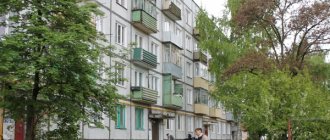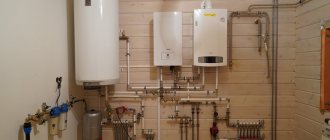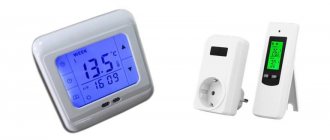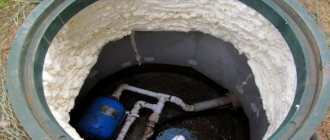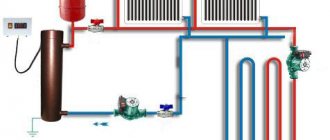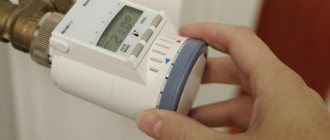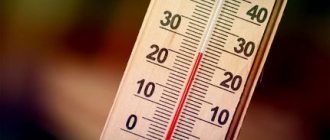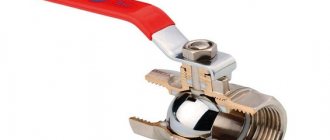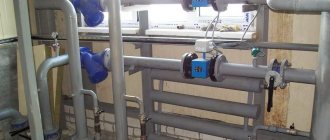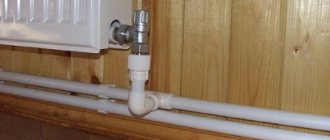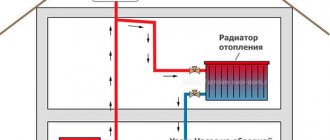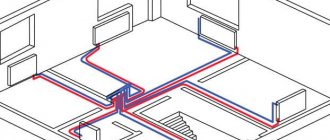The difference in using hot water between a country house and an apartment mainly lies in the fact that in an individual autonomous heating system you can always control and adjust the temperature and pressure of the coolant flowing through the pipes, but in a centralized heating system these parameters are set in the boiler room, and the owner of the apartment does not cannot affect the adjustment of the characteristics of the working fluid. But what the hot water temperature should be can be controlled in the apartment. This must be done at least to ensure that the temperature of the hot water supply and heating complies with the standards and ensures comfortable living and use of hot water in the bathroom, kitchen and other water points. Therefore, if during the year, instead of hot water of a certain temperature, you receive barely warm or even cold water, then you should think about how and where to write an application in order to achieve the targeted spending of your utility bills.
Standard DHW temperature
How the temperature range is set
Information about what temperature hot water should be in the water supply and central heating is set out in SanPiN 2.1.4.2496-09 (sanitary rules and regulations that determine the temperature of hot water supply and heating) and GOST R 51617-2000 (air temperature in the room when using heating and DHW). The parameters do not change for a long time, as they are determined by the appropriateness of these values - a person should feel comfortable and not experience any inconvenience when using hot water in one form or another.
Since the temperature of the water in the hot water supply depends on the technical solution for the water supply of the house or apartment, the temperature for the hot water supply and hot water supply routes will always be different. The temperature in the DHW system should not go beyond 600C-750C for all water points. If the DHW circuit is a closed type, then the minimum permissible water temperature should be 500C, for an open DHW it is 600C.
Housing and communal services standards contain the following permissible deviations: a decrease in temperature by 50C at night (from 0.00 to 5.00) and a decrease in temperature during the day by 30C (from 5.00 to 0.00). These rules are based not only on the comfort of using hot water, but also on the safety of residents. If the deviation from the regulations exceeds the specified limits for every 30C, residents have the right to demand that the payment for hot water supply be reduced by 0.1% for every 60 minutes of violation. If during control temperature measurements the thermometer showed a temperature of ≤ 400C, then payment for utilities is carried out according to the tariffs for cold water supply. To confirm the data, it is necessary to carry out an official measurement and draw up a report certifying the deviation from the SanPiN regulations.
If the water in the pipes is hot, it can cause burns, especially to children. In addition, modern pipe lines are made of plastic or metal-plastic, and high water temperatures have a destructive effect on them. When the temperature in the pipes exceeds 760C, a violation of the regulations occurs, just as when the temperature decreases to 560C, and residents have the right to write an individual or collective complaint against the utility company.
Normal temperature range
There is also another rule that forces you to regulate the hot water supply in the apartment within 60-750C. In warm water, microorganisms and pathogenic bacteria begin to multiply quickly and actively. Therefore, the temperature limit must cover the values. In which a person will not receive burns, but microorganisms will die without causing harm to consumers. This rule is especially relevant for children's and medical institutions.
Legionella, a bacterium that causes pneumonia of unknown etiology, multiplies well in warm fresh water. This means that in most cases the disease is not identified or is identified incorrectly, which leads to incorrect treatment with corresponding results, including death. But in hot water, Legionella dies depending on the temperature:
- At 70−800C, the water is completely disinfected - all bacteria die instantly;
- At 660C, legionella dies in 120 seconds;
- At a temperature of 600C, microorganisms die in 22 minutes;
- At 550C, bacteria die in 6-7 hours;
- At a temperature of 20−45°C, the active phase of legionella reproduction begins;
- At temperatures ≤ 20°C, Legionella cannot reproduce due to the cold.
Temperature graph of Legionella reproduction
Based on the above, it becomes clear that at high temperatures, the use of hot water is safe in terms of morbidity, but unsafe in terms of possible burns:
- When the water temperature in the hot water supply is ≤ 500C, there is a sufficient degree of risk of getting a burn;
- At temperatures ≥ 650C, skin burns occur within 2-5 seconds;
- At a water temperature of 55 °C, a burn can occur in one and a half minutes.
The problem is solved as follows: when hot water is centrally distributed to residential buildings, it is first stored in tanks where a temperature sufficient to kill bacteria is maintained. As hot water supply is supplied to the house, its temperature drops to a regulated level, and the use of hot water should be carried out only with the simultaneous connection of cold water supply to the house.
Burns depending on the water temperature in the DHW system
What are the types of hot water supply systems?
Currently, hot water supply is an integral part of the lives of most people on the planet. No apartment or residential building can live without it. Arranging a hot water supply system is a complex process; moreover, there are several types of connecting systems. In this article we will look at all hot water supply systems, calculations and types of water heaters.
We recommend reading: Antibiotics and drugs
A closed system implies separate operation of the coolant and hot water; it is also distinguished by the presence of a return and supply pipeline, which are used for circular circulation of water. Such a system will ensure normal pressure even when using a shower and sink at the same time. Among the advantages of the system, the ease of regulating the temperature of hot liquid is also noted.
Water quality in hot water supply
What is regulated by Snip, GOST and SanPin ? SanPiN Resolution 2.1.4.2496-09, clause 2.4 regulates the temperature standards for transporting water to residential buildings, and the maximum temperature limits for hot water in an apartment are 600C to 750C. In addition, hot water in the apartment should not have any foreign odors or taste impurities. If for some reason the temperature regulations are not observed, a complaint can be filed against organizations involved in the delivery of hot water to residential buildings in order to eliminate the cause of the violation of GOST. In each region, the application form will be original, so here are a few examples of such applications:
Statement of violation of hot water standards
https://youtu.be/1viQbRTzQ6A
Housing and communal services in Russia
5.3.1.
... The temperature of water supplied to water points (taps, mixers) must be at least 60 degrees. C in open hot water supply systems and at least 50 degrees. C - in closed. The water temperature in the hot water supply system must be maintained using an automatic regulator, the installation of which in the hot water supply system is mandatory. The water temperature at the outlet of the water heater of the hot water supply system must be selected from the condition of ensuring the normalized temperature at the water supply points, but not more than 75 degrees. WITH." According to the specified SanPiN, the temperature of hot water in places of water supply, regardless of the heat supply system used, must be no lower than 60 °C and no higher than 75 °C. These sanitary and epidemiological requirements for centralized hot water supply systems are aimed, among other things, at preventing contamination of hot water by highly contagious infectious pathogens of viral and bacterial origin that can multiply at temperatures below 60 degrees, including Legionella Pneumophila, as well as at preventing skin diseases and subcutaneous tissue, due to the quality of hot water (clauses 2.3 and 2.4).
How to measure temperature
To find out what hot water temperature is normal or not, first independent measurements are taken, and only after this it is necessary to invite official representatives of utility services to carry out official measurements and draw up relevant supporting documents.
To measure the temperature of hot water yourself, open any hot water tap and drain the water for 180 seconds, then fill any container with water (for example, a liter jar) and measure the temperature with a regular household thermometer. To do this, lower it into the jar for a few minutes and wait until the thermometer readings stop changing. If the thermometer shows too low or too high values, contact the utility companies with appropriate statements. If for some reason it is impossible to make a written application, then the dispatcher is obliged to accept an oral telephone complaint or an application for a control measurement by official representatives of the company. If the violation is eliminated without control measurements, the dispatcher is obliged to inform the applicant about this.
If the reason why the temperature schedule is violated is unknown, then a representative of the utility organization is obliged to arrive at the applicant for an official no later than 120 minutes after receiving any application - oral or written. Other time intervals are discussed with the applicant.
Repeated measurements of the DHW temperature are made by an official, after which a report on measuring the water temperature must be drawn up, and on the basis of this document, in the event of an obvious violation, the payment for DHW must be recalculated at other tariffs. The act is drawn up in two copies, one copy is sent to the management company, the second must be with the owner of the property.
DHW control measurement report
How to write a complaint to the management organization
If the hot water temperature schedule is violated constantly and regularly, then residents can write a collective or individual complaint against the management company that transports hot water. For a complaint to have legal force, it must be drawn up in a legally competent manner, citing facts and arguments. Any notary or lawyer can provide assistance in drawing up such a document.
The header of the document must contain the correct name of the organization against which the complaint is being made and the name of the responsible manager (if known to the complainant) to whom the document is addressed. Below are the personal details of the applicant: last name, first name, patronymic, address where the applicant is registered, contact information for subsequent communication regarding the application.
General complaint form:
- Document title;
- A statement that the temperature schedule is violated when providing residents with hot water according to the application form in accordance with Federal Law No. 195 under Article 7.23;
- The statement itself contains a description and essence of the complaint. It is necessary to write in the document that independent and control measurements of the hot water temperature were carried out with information from the previously drawn up report: date of measurement, personal data of the employee who carries out the control measurement of hot water temperature, temperature parameters;
- The complaint should end with a requirement to eliminate violations in the DHW supply or eliminate violations of the DHW temperature regime. In addition, you can oblige the company to inform you about the implementation of relevant work;
- At the end of the written complaint, the date of its preparation is indicated and the signature of the applicant is affixed. The complaint must be submitted and registered in 2 copies. The document is sent to the management organization by registered mail with notification, or is independently delivered by the applicant to the company’s office.
Complaint form to the housing and communal services management company
The second copy of the complaint, which remains with the applicant, must contain a mark on the acceptance of the document, and it must also indicate the date of receipt of the application and bear the seal of the management organization. The response to the complaint must be received no later than 30 working days.
How to request a recalculation if you deviate from the temperature schedule
How is the payment for hot water recalculated if the temperature schedule for hot water supply is violated? Having a control measurement report in hand, confirmed by an official of the management company, you need to visit the management organization to arrange a recalculation of the hot water service.
If the DHW temperature at the time of measurement was ≤ 400C, then the DHW consumption must be paid, in accordance with the law, according to tariffs for cold water. Thus, to carry out an official recalculation, you need to have on hand a certificate of measuring the DHW temperature. Before drawing up the act, an application for measurement is submitted; the document must contain the registration number, the time of acceptance into office work, and the data of the dispatcher who accepted the application. If the report was drawn up during a technical failure, and subsequently the temperature of the hot water returned to normal, the dispatcher is obliged to notify the applicant about this, indicating the timing of emergency operation of the hot water and the time to repair the breakdown in the pipeline.
If the hot water temperature is constantly low and the reasons for this decrease are unclear, you should decide with a company representative (dispatcher) about the time to carry out a control measurement of the hot water temperature. After measuring and drawing up several copies of the act according to the number of participants in the measurement, the document is sent to the authorities that approve or do not approve the need for recalculation.
In winter, measurements are taken taking into account the outside temperature and the thermal insulation conditions of the hot water supply line.
Temperature graph summary for DHW heat supply
Closed and open heat supply system: features, disadvantages and advantages
Connection of heat supply to the network is carried out in dependent and independent ways, implementing closed and open heat supply systems. The first is to supply water directly - using pumps and elevator units, where it is brought to the required temperature by mixing with cold water. An independent method is to supply hot water through a heat exchanger. It is more expensive, but the quality of water for the consumer is higher.
We recommend reading: All Benefits for Old Age Pensioners and Veterans with Long Work Experience in Bashkiria
The source of water heating is usually a gas or electric boiler. It is necessary to choose a method for flushing the system. In centralized systems, the hydrodynamic method is used. For autonomous use, you can use a chemical one. In this case, it is necessary to take into account the safety of the influence of reagents on radiators and pipes.
Features of measurements
- When measuring the temperature of the hot water supply, the water from the tap should be drained for at least 2-3 minutes;
- The draining time depends on the DHW supply pattern to the metering tank (for example, from an “independent” pipe or from a valve in the bathroom or kitchen).
The Code of the Russian Federation on Administrative Violations contains Article 7.23, which provides for punitive or administrative sanctions for violating the regulations for providing the population with hot water supply. Therefore, measurement and subsequent actions must be carried out officially and documented in order not only to establish the fact of a violation, but also to determine the exact time frame within which payment for DHW services will be recalculated. In this case, the initial period is considered to be the time of drawing up the measurement report, the final date for recalculation is the date of checking the compliance of the temperature regime of the hot water supply after eliminating the accident, breakdown or other reason for the violation of the schedule. If the management company refuses to recalculate, the applicant has the right to file a complaint with Rospotrebnadzor or the courts.
Sample complaint to Rospotrebnadzor
If violations fall within the scope of Federal Law No. 195 under Article 7.23, then the defendant may be fined, and the amount of the fine for an individual executing person may be 500-1000 rubles, for an organization – 5000-10000 rubles.
By paying for utilities, you have the right to demand that the management company perform your duties in full, and receive the appropriate quality of services and products for your money. Therefore, if you see that the service does not correspond to what was declared, do not be afraid to defend your rights and demand that the company providing the services fulfill its obligations. If you have complete information about DHW standards, temperature schedules and permissible deviations, you can challenge the unlawful actions of service provider companies, supporting your claims with relevant documents: measurement reports, applications for recalculation of payment for services, correctly completed complaints to higher authorities - Rospotrebnadzor or the court.
What to do if water does not meet SanPiN requirements
If you have a need to recalculate payments for inappropriate hot water delivery services, then your actions must take place within the legal framework, namely, comply with the requirements of Resolution No. 354 of the Government of the Russian Federation, which establishes the rules for the provision of utility services to consumers.
The requirements according to which your actions as an injured consumer will be regulated:
- If you find a violation, you must notify the dispatcher about it in writing or orally. In any case, do not forget to indicate your contact details - personal data, address, reason for contacting. The dispatcher is obliged to register your request and give it a go;
- In response, the dispatcher must inform you of his data, the registration number of your application and the time of its submission;
- the fact of a violation of the provision of services must be verified by the dispatch service and recorded. To do this, an additional verification of the violation is carried out together with the applicant, about which a report is drawn up. According to paragraph No. 108 of Resolution No. 354, such an inspection must be organized no later than two hours after receiving the complaint. Other times are agreed upon with the applicant;
- After the inspection, an act must be drawn up, based on the results of which violations will be eliminated. The document must contain a description of the violation, if it was detected, how and with what the control measurement of the hot water temperature was carried out, the time of measurement and the address at which all the described actions were carried out;
- Each participant in the inspection must have their own copy of the report, and the applicant must also have one copy.
If you, as an applicant and injured person, do not agree with the results of the inspection and measurements, you can request an additional examination. The repeated inspection is agreed upon and carried out in the same way as the initial one, only an expert is already involved in it. If, during a repeated inspection, the fact of a violation is not confirmed and recorded, then the costs of the examination will be borne by the applicant.
Extract from SanPiN 4723-88
Actions after receiving the act
After you have completed all the documents and received an act of violation of the quality of public services for the delivery of hot water, your further actions are to submit a request for recalculation of payment. You can find out the time for which the recalculation must be made from the information provided above.
The period of violation of the temperature schedule is considered:
- From the time of bringing information about the violation to the dispatcher;
- Until the time of testing to restore parameters.
If during this time the correct DHW has not been resumed, then the services with a violation of quality are considered incomplete, which means you have the right to submit a second claim.
DHW temperature: requirements and standards of SanPiN
Hygienic requirements and sanitary standards have a fairly wide range of use. They operate in trade, education, medicine, and the provision of public services. Their own rules have also been adopted in the field of hot water supply to consumers (SanPiN 2.1.4.2496-09). They relate to the quality of the supplied water, its temperature conditions, and the operation of centralized hot water systems.
In addition, it is possible to recalculate payment for the entire time the water does not meet the prescribed temperature regime. if the temperature was below the standard, then it is worth paying for hot water at the rates for cold water. According to the existing recalculation formula, the amount of payment is reduced by 0.1 percent for every three degrees of deviation from the norm.
